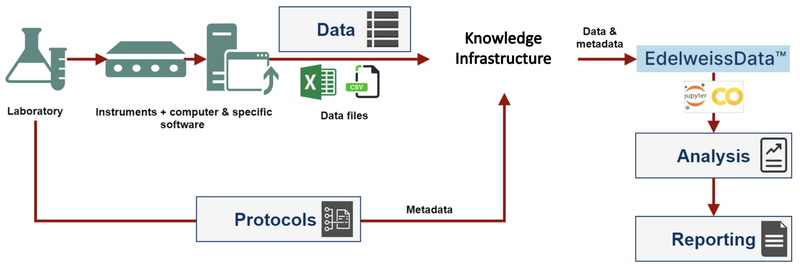About
Risk assessment of known and new chemical compounds is important to guarantee safety and sustainability during the development of new products where customers are exposed to. The key element of risk assessment of such compounds is their characterization in concern of a biological effect on molecular levels which might lead to an impaired cell function that causes diseases or even death. With our characterization solution packages we provide new approach methods for characterization of compounds, advanced materials and nanomaterials in the field of toxicology and next generation risk assessment.
The characterization process has been well defined by authorities for specific molecular endpoints. This is essential to ensure the validity of experimental data on which the characterization of compounds relies. Assessment workflows and criteria are summarized in Guidelines which have to be followed during risk assessment and include a variety of different assessment approaches such as in vivo, in vitro and in silico approaches.
All those approaches have in common that they are focusing on molecular key events for specific Adverse Outcome Pathways that lead to impairment of normal organ function. Thereby, we differentiate between:
In vivo characterisation
Whenever outcomes have to be studied where in vitro approaches cannot give clear results, such as the impact of chemicals on cognitive functions, including behaviour, in vivo assays can be done. Therefore, a variety of different model organisms exist, such as zebra-fish. In vivo characterisation takes into account key events that lead to specific adverse outcomes that can be measured and with which the compound can be categorised for this specific effect. Once enough data of good quality has been generated, it can be used in in silico models, so that no further animal experimentation is needed.
In vitro characterisation
With in vitro assays, compounds can be characterised based on their interaction with specific key events without the use of animal experimentation. Adhering to 3R principles, this approach contributes to green goals and animal welfare. With the development of more complex in vitro techniques, such as organoids or multiple organs on a chip, it becomes even possible to measure the effect of substances on organs and multiple organ functions ex vivo. At SaferWorldbyDesign we offer different solutions based on such techniques which you can check out by having a look at our partner contributions or by visiting our shop page.
In silico characterisation
In silico approaches in risk assessment offer the great possibility of evaluating compounds based on already existing data so that no animal experimentation and in vitro assays are needed. To ensure the integrity of data, enough data has to be included to give statistical value. It also has to be defined, what data has to be used for what kind of characterisation. This definition of work flows and characterisation procedure has been defined by authorities such as the OECD in guidelines that state the requirements to generate valuable data on the characterisation process. Based on those regulatory specifications, in silico tools can be developed that characterise compounds based on the comparison of specific features of molecules or materials with known ontological functions of already tested compounds.
At SaferWorldByDesign we provide solutions in a tiered strategy. As a first strategy we characterize compounds with our in silico machine learning approaches and, if needed, in further tiers with next generation in vitro assays. Thereby, we provide a well organized data management infrastructure under FAIR principles to guarantee the integrity of results.
